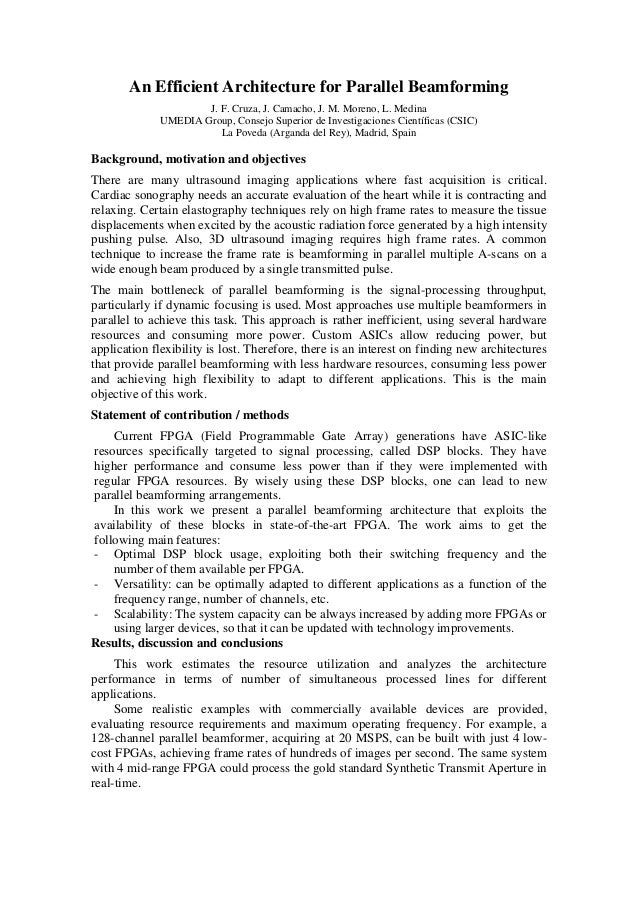
An efficient architecture for parallel beamforming
- 1. An Efficient Architecture for Parallel Beamforming J. F. Cruza, J. Camacho, J. M. Moreno, L. Medina UMEDIA Group, Consejo Superior de Investigaciones Científicas (CSIC) La Poveda (Arganda del Rey), Madrid, Spain Background, motivation and objectives There are many ultrasound imaging applications where fast acquisition is critical. Cardiac sonography needs an accurate evaluation of the heart while it is contracting and relaxing. Certain elastography techniques rely on high frame rates to measure the tissue displacements when excited by the acoustic radiation force generated by a high intensity pushing pulse. Also, 3D ultrasound imaging requires high frame rates. A common technique to increase the frame rate is beamforming in parallel multiple A-scans on a wide enough beam produced by a single transmitted pulse. The main bottleneck of parallel beamforming is the signal-processing throughput, particularly if dynamic focusing is used. Most approaches use multiple beamformers in parallel to achieve this task. This approach is rather inefficient, using several hardware resources and consuming more power. Custom ASICs allow reducing power, but application flexibility is lost. Therefore, there is an interest on finding new architectures that provide parallel beamforming with less hardware resources, consuming less power and achieving high flexibility to adapt to different applications. This is the main objective of this work. Statement of contribution / methods Current FPGA (Field Programmable Gate Array) generations have ASIC-like resources specifically targeted to signal processing, called DSP blocks. They have higher performance and consume less power than if they were implemented with regular FPGA resources. By wisely using these DSP blocks, one can lead to new parallel beamforming arrangements. In this work we present a parallel beamforming architecture that exploits the availability of these blocks in state-of-the-art FPGA. The work aims to get the following main features: - Optimal DSP block usage, exploiting both their switching frequency and the number of them available per FPGA. - Versatility: can be optimally adapted to different applications as a function of the frequency range, number of channels, etc. - Scalability: The system capacity can be always increased by adding more FPGAs or using larger devices, so that it can be updated with technology improvements. Results, discussion and conclusions This work estimates the resource utilization and analyzes the architecture performance in terms of number of simultaneous processed lines for different applications. Some realistic examples with commercially available devices are provided, evaluating resource requirements and maximum operating frequency. For example, a 128-channel parallel beamformer, acquiring at 20 MSPS, can be built with just 4 low- cost FPGAs, achieving frame rates of hundreds of images per second. The same system with 4 mid-range FPGA could process the gold standard Synthetic Transmit Aperture in real-time.
- 2. The architecture has high scalability, mainly restricted by communication bandwidth between FPGA devices, that linearly with the number of parallel beamformed lines.
